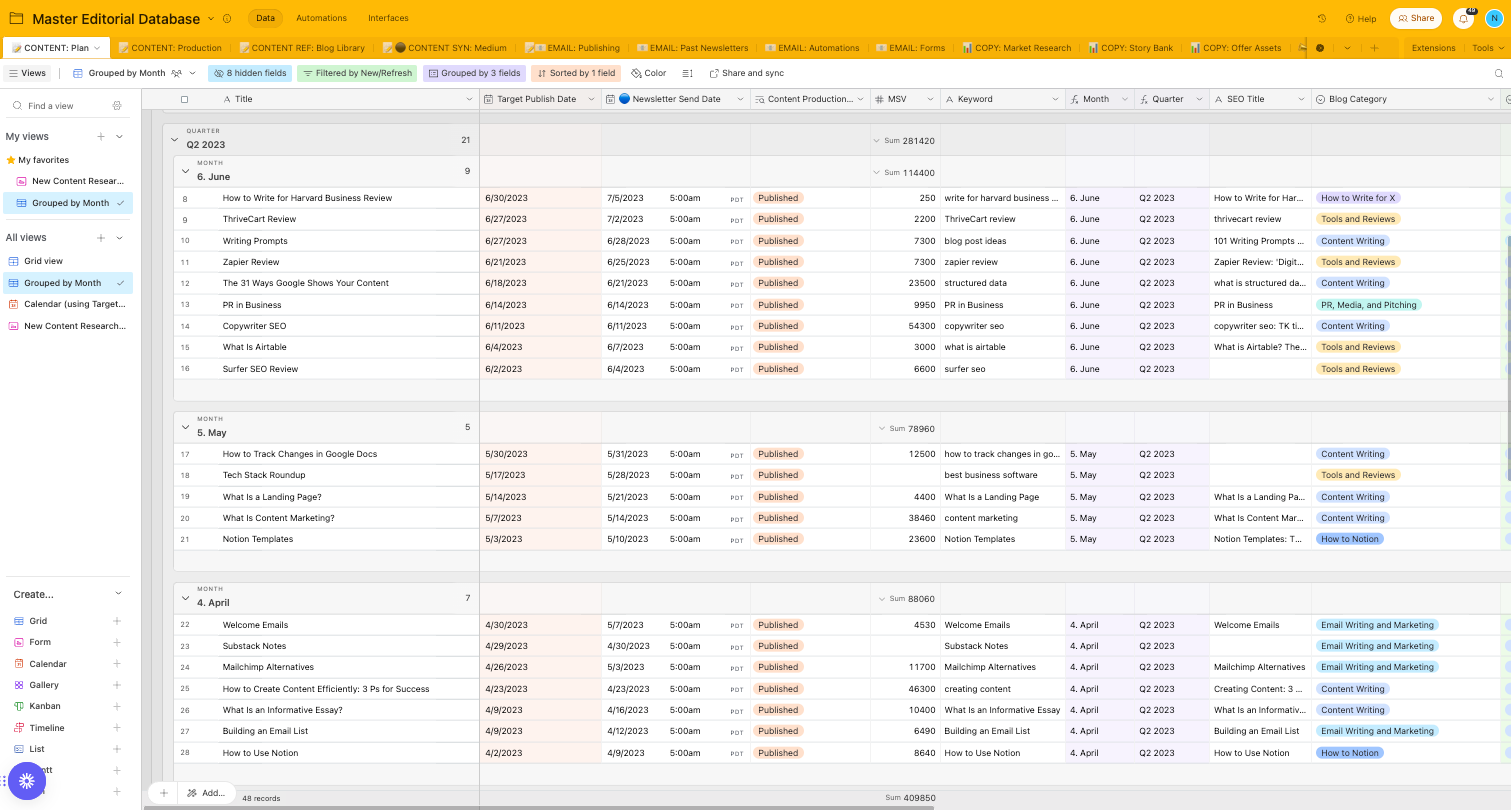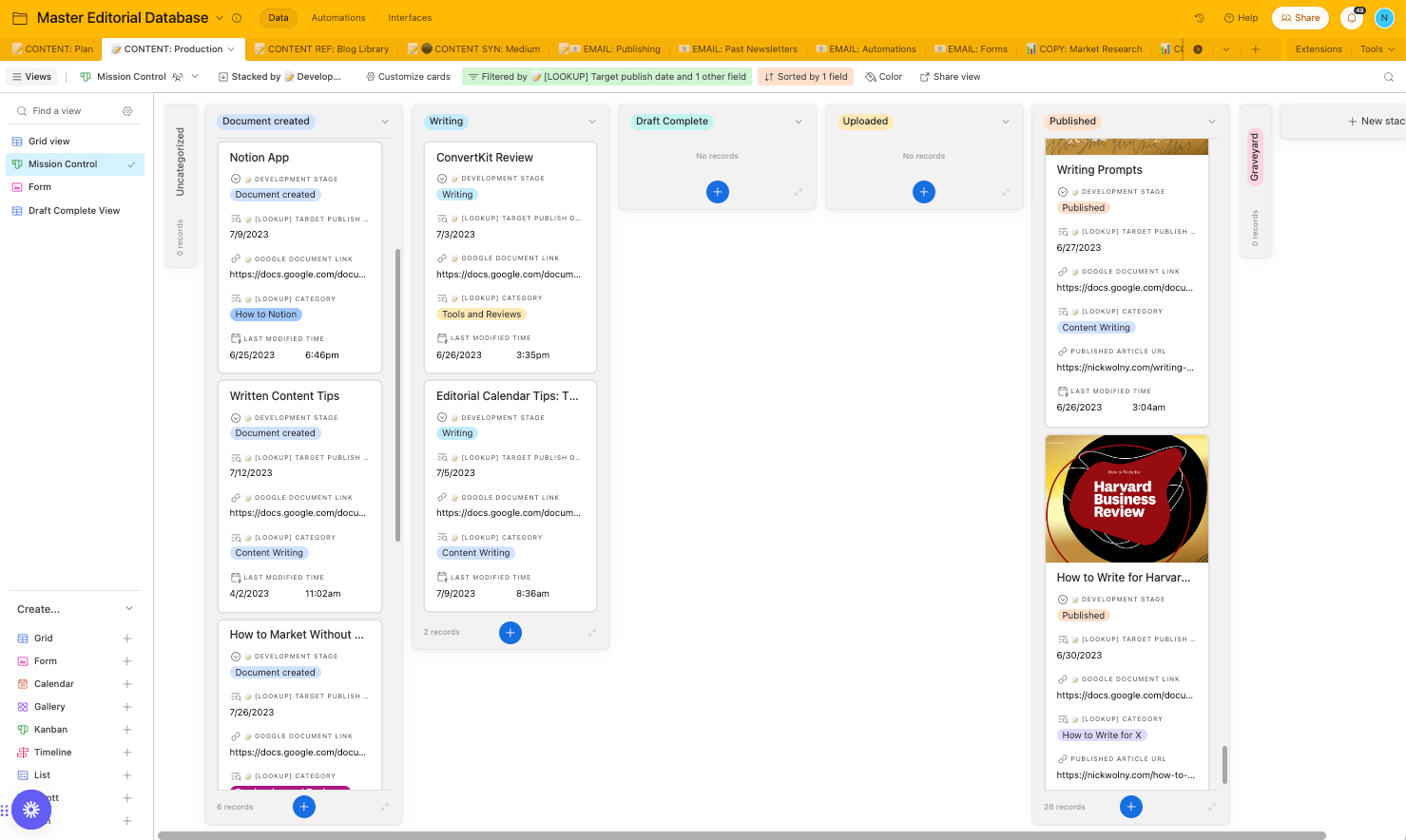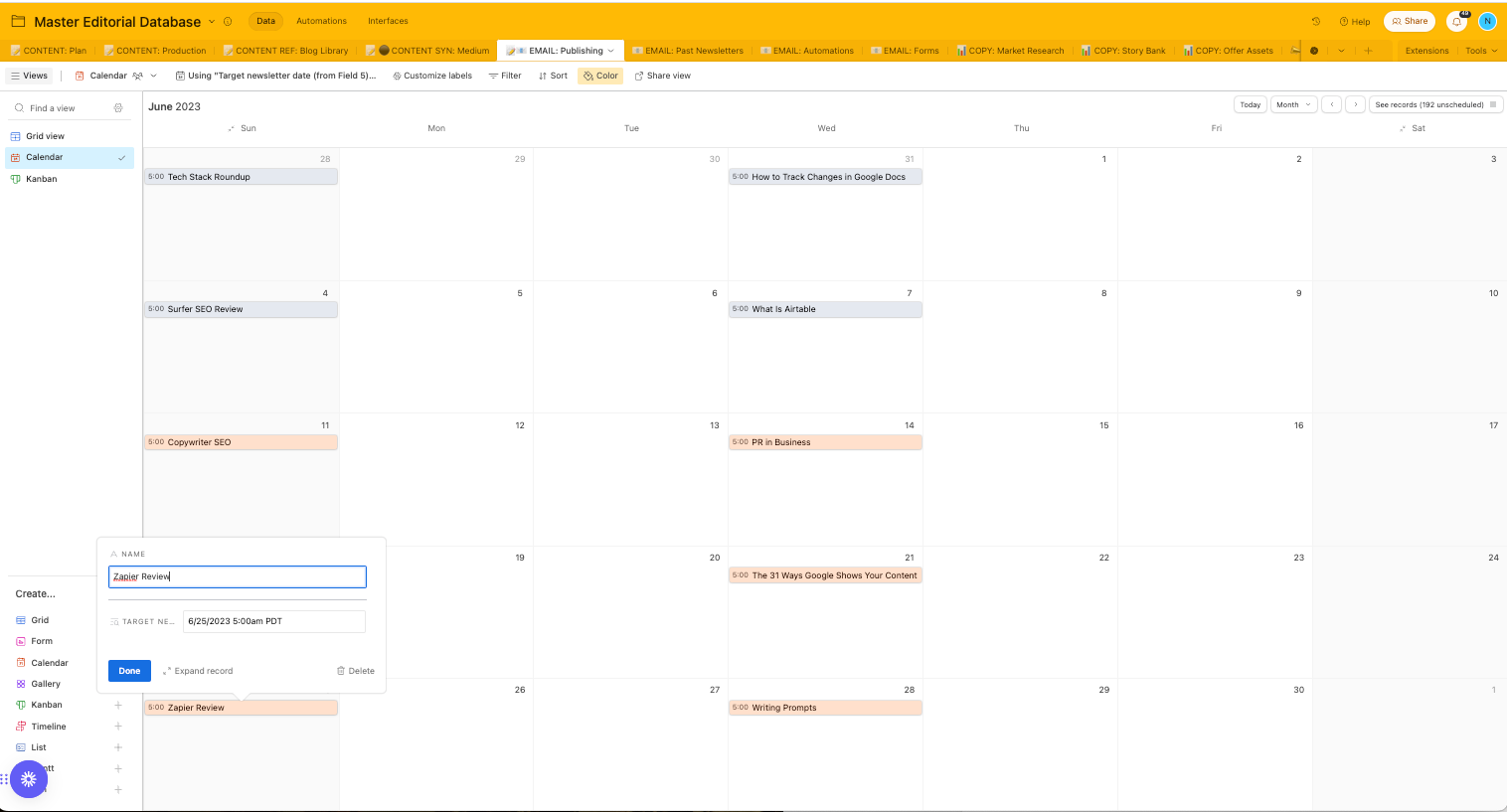You don’t need more hustle. You need more focus.
An editorial calendar helps you organize your content creation process across multiple channels. When you have one “source of truth” for all your marketing materials, it’s easy to hop in and pick back up where you left off in your overall publishing workflow.
Editorial calendars are common for marketing teams and media publishers, but having your own editorial calendar as a content creator or entrepreneur also has its perks.
Key Takeaways
- Content calendars work for all types of modalities, whether you’re working with blogs, video content, imagery, graphics, or audio.
- A good organizational system will include solutions for content ideas, content production, and other project management tools.
- A good editorial calendar software to consider is Airtable. Asana, Trello, ClickUp, and Google Sheets are also popular options.
- Like other disciplines in life, it takes practice to publish content consistently. An effective editorial calendar ensures you’re developing good habits and being honest with yourself when you veer off course.
Let’s go over why you should consider having an editorial database.
Table of Content
Why Prioritize a Content Strategy?
Research shows that 72% of customers consume three or more pieces of content before making their first purchase. Quality content informs your audience and gives them social cues about how you work and what you believe in.
Content marketing is an integral component of many marketing objectives, and whether you’ve defined ‘em or not, you have marketing objectives. Keep one or more of the following goals in mind.
- Growing an audience: A bigger audience often means more opportunities. One way to grow your audience is by publishing valuable information on platforms where that information can get distributed to your target audience.
- Getting more clients: Content informs and inspires your readers. It can educate them on why they should work with someone like you. Whether it’s actually you or someone else, they’ll appreciate learning more about your industry.
- Monetization opportunities: Many creators never sell a product, program, or service. Instead, they show display ads, promote affiliate links for commissions, or partner with brands. You don’t have to sell your readers directly in order to monetize your content.
Related: How to Create Content Efficiently: 3 Ps for Success
Why Create an Editorial Calendar?
Turning a content idea into a published blog post is easier said than done. A content marketing editorial calendar template can help you define your publishing schedule, organize keyword research, and better define the distribution channels you want to use to reach your readers.
A popular project management tool I use with both myself and my clients is Airtable. Airtable features drag-and-drop functionality, space for publishing dates, and a way to assign tasks if I want to bring an assistant into the picture. There is also an actual calendar view, which makes it easy to look at scheduled social posts or publication dates all in one place.

Users pick up on consistency. When you publish content on a regular basis, you build trust with your existing readers and attract new ones, too.
Prioritize published content that will be relevant for a long time so that you can build up a library of resources that your readers will love.
5 Components to Include in Your Editorial Calendar
No. 1: A Space for Planning and Keyword Research.
It can be tempting to create a quick post, publish, and get the endorphin rush of feeling like you accomplished something.
Real talk: Did that quick-and-dirty post move you closer to your goals? Be honest.
Professional marketers and publishers always start with a content plan. They not only know what content they’re going to produce and publish, but also why they’re spending time and resources to do so.
Whether it be keyword planning, market research, or just doing more of what works, this content planning gives you confidence. Marketing will feel less like trying to shoot fish in a barrel.
Pro Tip:Not every idea has to become a piece of content. Use the “planning content” section of your editorial database to brainstorm, then move viable ideas you’re excited about into your content pipeline.
No. 2: Content Production Kanban Boards.
Whether you’re writing articles, producing videos, or recording podcast episodes, the journey from idea to finished product has multiple steps. Ensure your editorial calendar template has different verticals for production so that it’s easy to hop right back in wherever you left off.
A popular content management interface project managers and content marketers like to use is the kanban board. Kanban boards are great for team productivity, because you can easily see at a glance what the next action step is for any one particular project.
In my editorial database, for example, I can see where I’m at in my content efforts, as well as exact dates for both publish due dates and newsletter sends.

Having your content in stages also lets you incorporate automations. For example, I have an automation that tells my virtual assistant my blog post is ready to be uploaded when I move the card to a certain column of the kanban board.
Consider organizing your upcoming content with a data management system that includes kanban boards. Software tools like Airtable, Asana, and Trello all have a free template that includes kanban board functionality.
No. 3: Reference Libraries.
Did you know that a report from McKinsey found that American workers spend 1.8 hours each day just looking for information or files? That’s time you could be using to write or relax instead.
Consider including one or more reference tabs in your editorial database. Tabs that quickly link to your past blog posts or social media posts, email campaigns, and brand assets can really cut down on mental friction.
No. 4: A Calendar Interface.
Your editorial calendar should have, well, a calendar! Most software tools include calendar apps or other calendar interfaces that make this process simple.
Calendars will help you ensure you’re scheduling content to publish in line with your content plan. It’s also easy to export your blog calendar or other content calendar to a Google Calendar if that’s where you manage deadlines.

No. 5: Syndication Plans.
It’s not unusual for businesses and brands to take one idea and develop it into multiple content formats. In fact, this is encouraged. Rather than talk about lots of topics, strive to publish about a few topics in many different ways.
Using a content management tool like Airtable as your editorial calendar template can help you manage cross-platform projects with ease.
Content Calendar FAQs
What are the Best Formats for Editorial Calendars?
Most project management tools work well as editorial calendar tools. Consider a tool that you can manage by yourself, but also one that a marketing team member could join at a later date to help you execute your content marketing strategy.
What Is the Difference Between an Editorial Calendar and a Content Calendar?
A content calendar focuses more on publish dates and coordination across promotional channels. An editorial calendar zeroes in more on the why behind your content, incorporating strategies like keyword research and defining the different stages of your content workflow.
What Digital Marketing Strategy Should I Prioritize First?
Get your website and email list signup process in order first. Then, to grow your list, publish your company’s content on different platforms with distribution in mind.
For example, if you’re blogging and want to reach new readers, prioritize posts that search engines can index in relation to terms that users typically search for. This strategy is known as SEO, and it’s a great way to escape the social media noise and bring new traffic to your website every month without doing more work.
Related: 10 SEO Copywriter Tips to Get More Eyeballs On Your Website
How Can I Track Content Performance?
- Measure metrics like page views, video views, saves, shares, and signups on your posts.
- Measure change in performance from month to month.
- Consider also measuring adherence. Do you say you’ll publish 10 blog posts a month, and then only publish two? If so, that’s a forecasting problem. Figure out what it actually takes to publish a piece of content so that you can plan more effectively and feel more successful.
Create an Editorial Calendar Today
You don’t need to have the best content marketing editorial calendar on Earth to start planning. But you should create an editorial calendar to house your content ideas.
Doing so will help you implement marketing campaigns that make you feel more like you’re in the driver’s seat of your online business efforts. ◆
Thanks For Reading 🙏🏼
Keep up the momentum with one or more of these next steps:
📣 Share this post with your network or a friend. Sharing helps spread the word, and posts are formatted to be both easy to read and easy to curate – you'll look savvy and informed.
📲 Hang out with me on another platform. I'm active on Medium,Instagram, and LinkedIn – if you're on any of those, say hello.
📬 Sign up for my free email list. This is where my best, most exclusive and most valuable content gets published. Use any of the signup boxes on the site.
🏕 Up your writing game. Camp Wordsmith® is a content marketing strategy program for small business owners, service providers, and online professionals. Learn more here.
📊 Hire me for consulting. I provide 1-on-1 consultations through my company, Hefty Media Group. We're a certified diversity supplier with the National Gay & Lesbian Chamber of Commerce. Learn more here.


